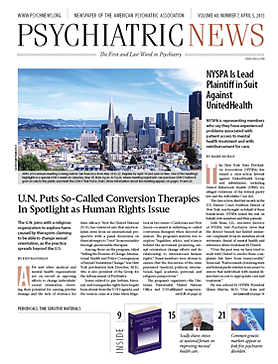“Bullying is not just a harmless rite of passage or an inevitable part of growing up,” William Copeland, Ph.D., an associate professor of psychiatry at Duke University, and colleagues said in a report in the February 20 JAMA Psychiatry. “Victims of bullying are at increased risk for emotional disorders in adulthood.”
This was the conclusion of Copeland and his colleagues after conducting what they described as “the first study to explore prospectively the association between peer victimization in childhood and adult psychiatric diagnoses and suicidality.”
The study included approximately 1,400 subjects who were evaluated periodically during childhood, adolescence, and young adulthood to determine their involvement in bullying and symptoms of psychiatric disorders.
The subjects were categorized as bullies, victims, bullies/victims, or neither (controls). Five percent were found to be bullies only, 22 percent were victims only, and 5 percent were both bullies and victims. The researchers assessed, after taking childhood hardship or psychiatric disorders into consideration, whether bullies, victims, or those who were both were more prone to developing psychiatric disorders as young adults than controls.
As it turned out, all three groups of subjects involved in bullying were at higher risk for a psychiatric disorder than the controls. Compared with controls, those who had been bullies were four times more likely to have antisocial personality disorder. Youth who had been bullying victims were five times more likely to have agoraphobia, three times more likely to have generalized anxiety disorder, and three times more likely to have panic disorder.
And youngsters who had been both bullies and victims were five times more likely to have major depressive disorder, 15 times more likely to have panic disorder, and in the case of males, 19 times more likely to be suicidal than their peers with no bullying involvement. The researchers also found that the psychiatric outcomes did not differ significantly depending on whether the bulling involvement occurred once or multiple times.
Assuming that bullying during childhood does contribute to psychiatric illness in early adulthood, how might it do so? Perhaps, the researchers suggested, by altering an individual’s physiological response to stress. Bullying victimization has been found in prior studies to alter activity in the hypothalamic-pituitary-adrenal axis, and an altered cortisol response is associated with an increased risk for developing depression.
The researchers also looked at personality characteristics that might make it more likely that a youngster will be a bullying victim. Their data, as well as data from other studies, suggest that victims tend to be withdrawn, unassertive, and easily emotionally upset, and those who are both bullies and victims are apt to be aggressive, easily angered, and often mistreated by their siblings. “This pattern has been interpreted to suggest that victimization occurs within a context of other risk factors and may not be causal in predicting later outcomes in and of itself,” Copeland and colleagues stated in their report.
The study was funded by the National Institutes of Health, the Brain and Behavior Research Foundation, and the William T. Grant Foundation. ■

